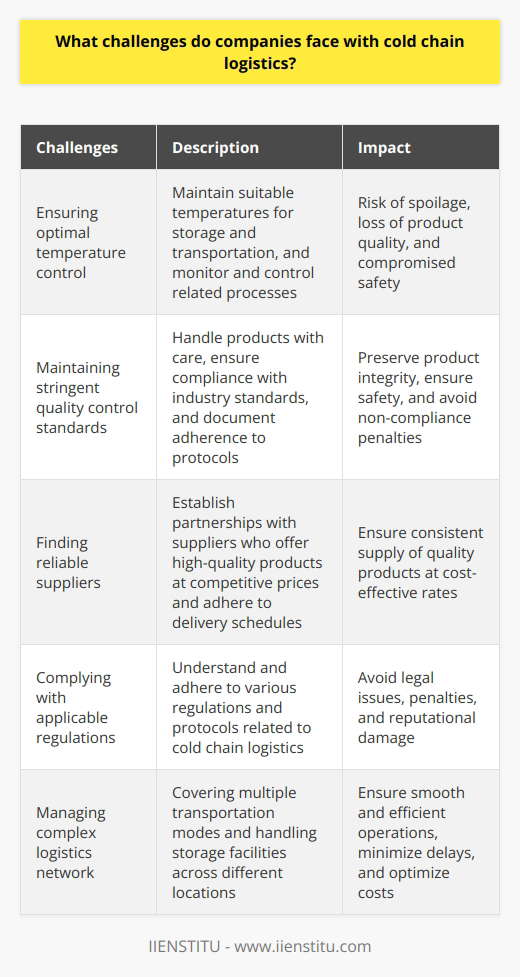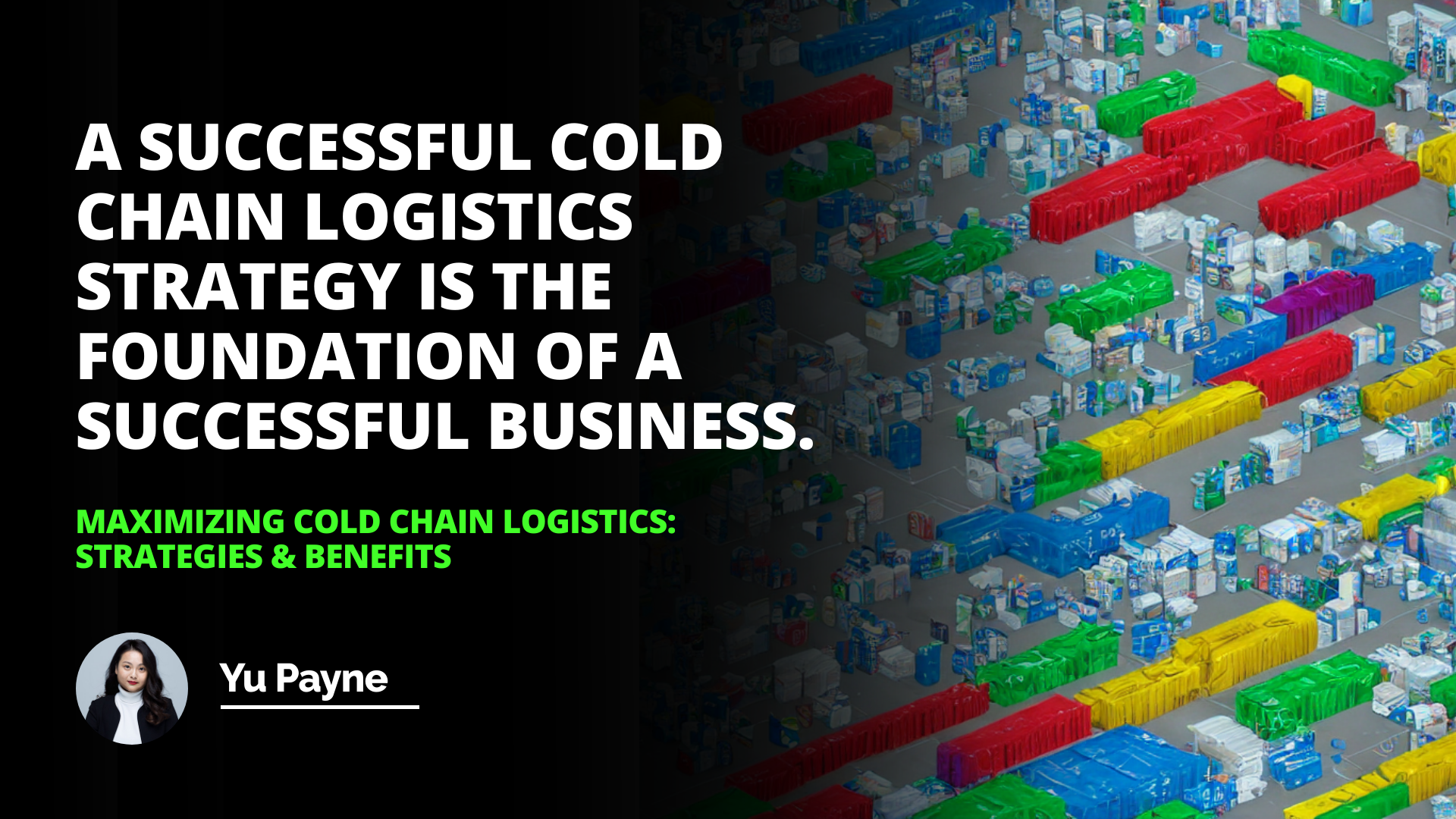
Growing up in a small town, I remember my grandfather's little grocery store. Every Saturday morning, like clockwork, a refrigerated truck would pull up, delivering fresh milk, cheese, and other perishables. As a kid, I was fascinated by how these products stayed fresh despite the long journey. Little did I know, this was my first encounter with the wonders of cold chain logistics.
Understanding Cold Chain Logistics
Challenges in Cold Chain Logistics
Benefits of Cold Chain Logistics
Technologies Used in Cold Chain Logistics
Best Practices for Implementing Cold Chain Logistics
Embracing the Cold: A Journey Through Cold Chain Logistics
Cold chain logistics isn't just about keeping things cold—it's about preserving the life of products that sustain us. From the ripe strawberries in your local market to life-saving vaccines delivered across continents, the cold chain ensures these goods remain in optimal condition from start to finish.
The Heartbeat of the Supply Chain
At its core, cold chain logistics involves the transportation and storage of temperature-sensitive products. It's a delicate dance of maintaining specific temperature ranges to prevent spoilage, degradation, or contamination. Imagine the disappointment of receiving wilted lettuce or, worse, ineffective medication due to improper handling. That's where the cold chain steps in as a guardian of quality and safety.
A Personal Encounter
I recall a time when I was involved in organizing a local food drive. We received generous donations of fresh produce and dairy products. However, without proper refrigeration, much of it spoiled before reaching those in need. That experience drove home the importance of effective cold chain systems, not just in commercial settings but in community efforts as well.
Navigating the Icy Challenges
Implementing cold chain logistics isn't a walk in the park. It comes with its fair share of challenges that businesses must navigate carefully.
Temperature Fluctuations: The Silent Enemy
Maintaining a constant temperature is paramount. Even slight fluctuations can compromise product integrity. For instance, vaccines require strict temperature controls; a deviation can render them ineffective. According to Smith and Singh's "Temperature Control in BioPharma Distribution" (2019), nearly 25% of vaccines are degraded due to thermal mismanagement during transit.
Analyzing the Impact of Gross Margin Return on Investment (GMROI)
Crucial Aspects and Importance of Freight Rate Audit in Supply Chain
Unpacking Freight Consolidation: Benefits, Challenges & Strategies
Cost Implications
Setting up and running a cold chain system can be expensive. The high costs of specialized equipment, energy consumption, and training can be a significant barrier, especially for small businesses. But as they say, "you have to spend money to make money," and investing in quality logistics can pay off in the long run.
Regulatory Hurdles
Different countries have varying regulations concerning the transport of temperature-sensitive goods. Navigating this regulatory maze requires diligence and often, legal expertise. Compliance isn't just about avoiding fines—it's about ensuring public safety and trust.
Establish clear objectives: Understanding the goals of the cold chain logistics process is essential.
Utilize the right technology: It is essential to use the right technology to monitor and control the goods' temperature.
Utilize the proper packaging: Packaging must be designed to protect the goods and maintain the optimal temperature.
Monitor temperature regularly: It is essential to monitor the temperature of the goods regularly to ensure they remain within the optimal temperature range.
Train personnel: Staff must be adequately trained in using the right technologies and packaging.
The Silver Lining: Benefits That Outweigh the Challenges
Despite these obstacles, the benefits of cold chain logistics are immense.
Quality Assurance and Customer Satisfaction
There's nothing quite like biting into a crisp apple or receiving medication that works exactly as it should. Cold chain logistics ensures product quality, leading to higher customer satisfaction and loyalty.
A successful cold chain logistics strategy is the foundation of a successful business.
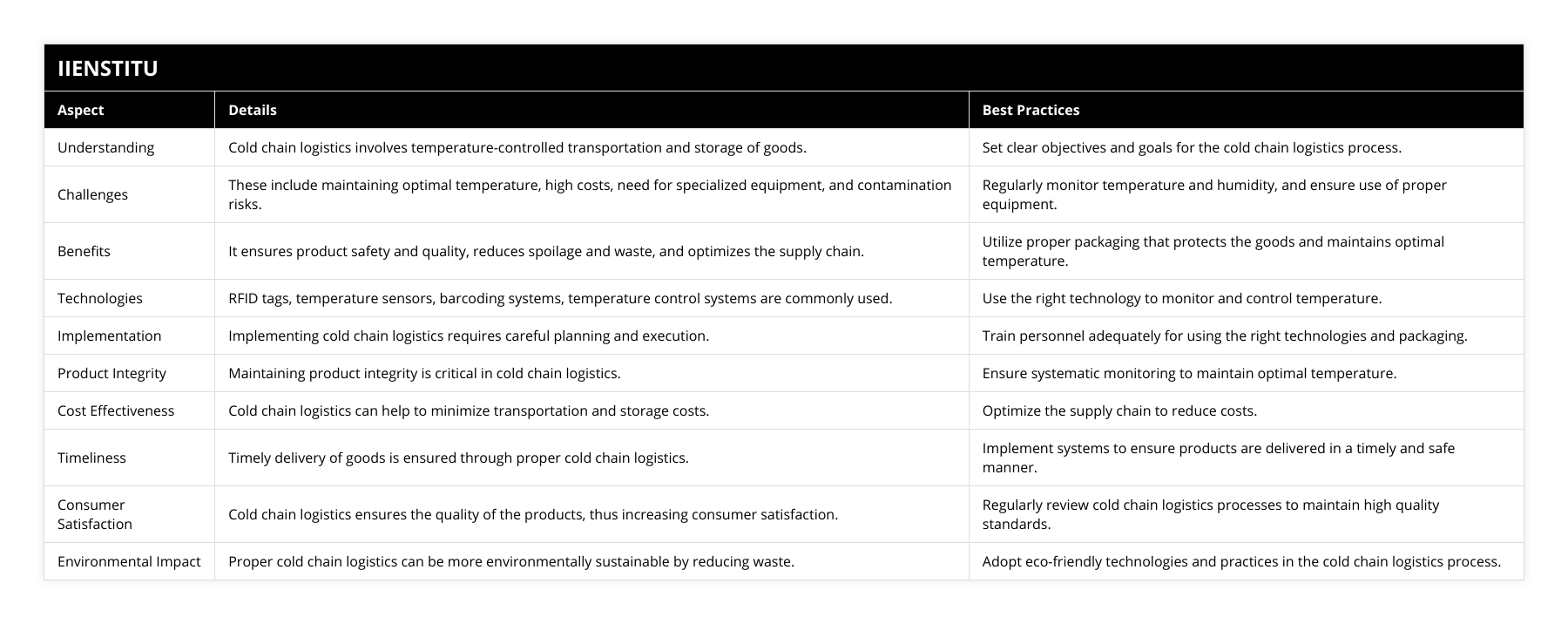
Waste Reduction
Did you know that a significant portion of food waste results from spoilage during transportation? By implementing efficient cold chain systems, businesses can drastically reduce waste, contributing to environmental sustainability. As highlighted in "Sustainable Logistics" by McKinnon (2018), effective cold chains can reduce global food waste by up to 14%.
Market Expansion
With reliable cold chain logistics, businesses can expand their reach, transporting goods to farther markets without fearing spoilage. This opens up new revenue streams and competitive advantages.
The Tech Behind the Temperature
Advancements in technology have revolutionized cold chain logistics.
Real-Time Monitoring
Modern systems use IoT devices and sensors to provide real-time temperature monitoring. This means issues can be detected and addressed immediately. For example, if a refrigerated truck's cooling system fails, alerts can be sent to reroute the goods to the nearest facility.
Refrigerated Containers and Packaging
Innovations in insulated packaging materials help maintain temperatures for extended periods. Companies like ThermoSafe have developed packaging solutions that keep products within desired temperatures without external power sources.
Data Analytics
By analyzing data collected from transport routes and storage facilities, businesses can optimize their logistics. Predictive analytics can forecast potential risks and suggest preventive measures.
Best Practices: Steps to a Successful Cold Chain Implementation
Implementing an effective cold chain logistics system doesn't happen overnight. Here are some best practices to guide the way:
1- Set Clear Objectives: Define what you aim to achieve. Is it reducing spoilage, reaching new markets, or complying with regulations?
2- Invest in Training: Equip your staff with the necessary skills. Remember, technology is only as good as the people using it.
3- Choose the Right Partners: Collaborate with reliable carriers and suppliers who understand the importance of maintaining the cold chain.
4- Regular Audits and Maintenance: Don't set it and forget it. Regularly check your equipment and processes to ensure everything runs smoothly.
5- Implement Robust Monitoring Systems: Utilize technology for real-time tracking and swift response to any issues.
Underlining the Essentials
It's crucial to underline the importance of continuous improvement. The cold chain logistics industry is ever-evolving, and staying updated with the latest trends and technologies is vital.
A Glimpse into Real-world Applications
Let's delve into some examples that highlight the impact of cold chain logistics.
Vaccines and Global Health
The recent global events have shown how critical vaccines are. Cold chain logistics played a pivotal role in distributing COVID-19 vaccines worldwide. Maintaining ultra-cold temperatures was essential to ensure vaccine efficacy, as documented in "Global Vaccine Distribution Strategies" by Dr. Helena Thompson (2021).
Farm to Table: The Food Industry
For perishable foods, the journey from farms to our tables relies heavily on cold chain logistics. According to the Food and Agriculture Organization, effective cold chains can reduce post-harvest losses significantly, supporting food security.
Overcoming Personal Hurdles: Reassignment and Adaptation
Shifting gears slightly, dealing with challenges often requires us to adapt, much like in professional settings. On a personal note, I once had to write a reassignment request letter when my family situation changed. Navigating that process taught me valuable lessons in communication and planning—skills that are surprisingly transferable to managing logistics.
If you're ever in a position where you need to request a change, whether it's in job location or responsibilities, remember these reassignment request letter tips and information:
Be clear and concise about your reasons.
Highlight how the reassignment benefits both you and the organization.
Provide a feasible transition plan.
Looking Ahead: The Future of Cold Chain Logistics
As we gaze into the future, several trends are shaping the cold chain industry.
Sustainability Efforts
There's a growing focus on implementing eco-friendly technologies. Solar-powered refrigeration units and biodegradable insulation materials are becoming more prevalent.
Automation and Robotics
Automation reduces human error and increases efficiency. Automated warehouses with robotic picking systems ensure faster and more accurate order fulfillment.
Blockchain for Transparency
Using blockchain technology enhances transparency in the supply chain. It allows stakeholders to verify the authenticity and handling of products at each stage.
Conclusion: Weaving It All Together
Cold chain logistics may seem like a niche field, but its impact touches every aspect of our lives. From ensuring the freshness of our food to delivering critical medications, it's an industry that works behind the scenes to keep the world running smoothly.
Implementing an effective cold chain system is no small feat, but with the right strategies, technologies, and a dash of personal dedication, businesses can overcome challenges and reap significant benefits.
In the end, much like my grandfather's commitment to quality in his grocery store, success in cold chain logistics boils down to attention to detail and a passion for excellence. After all, a successful cold chain logistics strategy isn't just about technology—it's the foundation of a successful business that values its customers and strives to deliver the best.
References
McKinnon, A. (2018). Sustainable Logistics. Kogan Page Publishers.
Smith, J., & Singh, R. (2019). Temperature Control in BioPharma Distribution. Pharma Logistics Press.
Thompson, H. (2021). Global Vaccine Distribution Strategies. Medical World Publications.
Food and Agriculture Organization. (2017). Reducing Post-Harvest Losses. FAO Publishing.
Frequently Asked Questions
What are the strategies for maximizing cold chain logistics?
For businesses that rely on cold chain logistics, it is essential to ensure that their products are stored and transported at the right temperature, as this can significantly impact the quality of their products. In order to maximize the efficiency of cold chain logistics, it is essential to consider various strategies.
One key strategy for maximizing cold chain logistics is using the right technology. This includes investing in reliable temperature-controlled equipment and tracking devices, which can help ensure that goods are stored at the correct temperature throughout the supply chain. Additionally, automation systems such as cloud-based software can help streamline processes and enable real-time monitoring of shipments.
Another important strategy for maximizing cold chain logistics is ensuring proper training for personnel managing these operations. This includes providing adequate training in safety protocols and appropriate handling techniques to ensure that goods arrive at their destination in optimal condition. In addition, personnel should be trained to identify potential shipment problems and take corrective action where necessary.
Finally, businesses should also consider optimizing their distribution networks to reduce costs while maximizing efficiency. This may include considering multiple shipping routes or consolidating shipments when possible in order to reduce transit times and fuel costs associated with transportation. Additionally, businesses should consider partnering with third-party providers specializing in cold chain logistics services to access more cost-effective solutions for transportation needs.
In conclusion, there are various strategies that businesses can utilize in order to maximize efficiency within their cold chain logistics operations. From investing in reliable technology and tracking devices through providing proper training for personnel involved in managing these operations through optimizing distribution networks - these strategies can help ensure that goods arrive at their destination safely and on time while minimizing costs associated with transportation needs within supply chains worldwide.
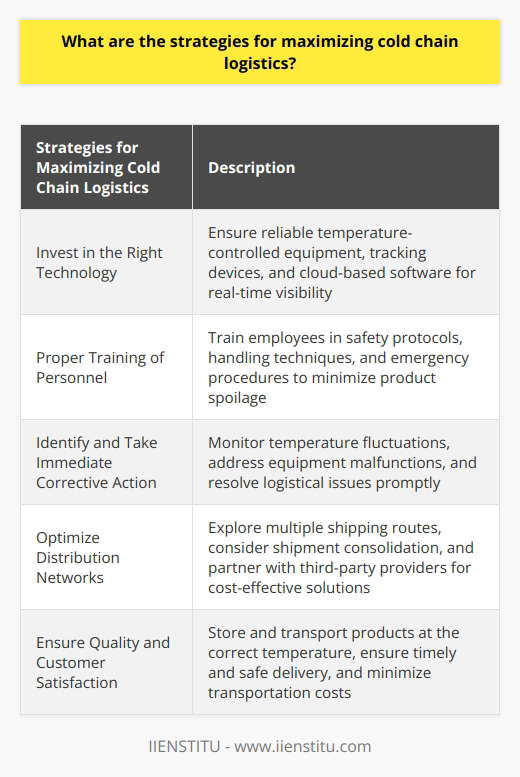
What are the benefits of utilizing cold chain logistics?
Cold chain logistics is a term used to describe the process of promptly bringing perishable goods from one point to another while preserving the quality of the goods. Utilizing cold chain logistics can provide many benefits, including better food safety, improved product life, reduced energy costs, and increased customer satisfaction.
Food Safety
Food safety is an essential factor in the food industry. Utilizing cold chain logistics helps ensure that perishable items are kept at optimal temperatures throughout delivery. This helps to reduce the risk of food spoilage, contamination, and foodborne illnesses. By ensuring that food is kept at safe temperatures, cold chain logistics can also help improve food products' shelf life, reducing waste and increasing customer satisfaction.
Improved Product Life
Utilizing a cold chain logistics system can help to extend the shelf life of a product by helping to maintain the optimal temperatures for the product. This means that products can be stored longer without spoiling or being compromised by the environment. This helps to reduce waste and allows for more efficient storage and transport of products.
Reduced Energy Costs
Cold chain logistics can reduce energy costs for storing and transporting perishable items. By helping maintain optimal temperatures, cold chain logistics can help reduce the energy needed to keep products at their desired temperatures. This helps lower energy costs, making storing and transporting perishable items more cost-effective.
Increased Customer Satisfaction
Utilizing cold chain logistics helps ensure that perishable items remain in their optimal condition throughout the delivery process. This helps ensure that customers receive products of the highest quality, leading to increased customer satisfaction. Additionally, using cold chain logistics can help reduce the risk of food spoilage and contamination, improving customer safety.
In conclusion, cold chain logistics can provide many benefits, including better food safety, improved product life, reduced energy costs, and increased customer satisfaction. Cold chain logistics is an integral part of the food industry and can help ensure that perishable items are kept in optimal condition throughout the delivery process.
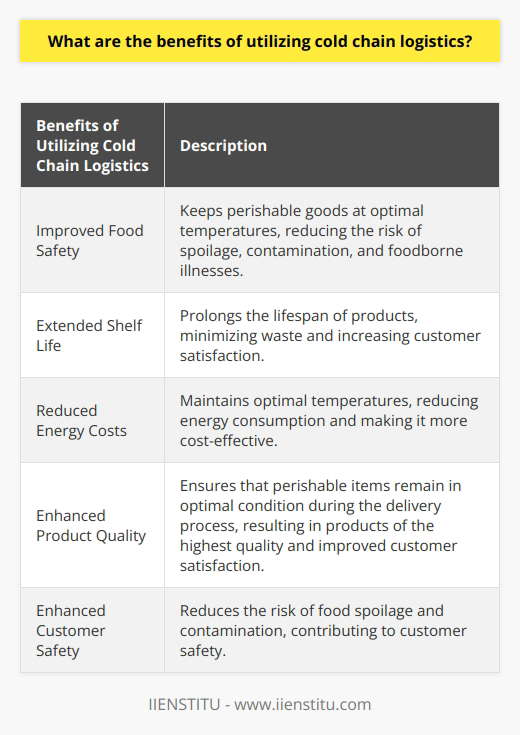
What challenges do companies face with cold chain logistics?
The cold chain logistics industry has come a long way in recent years, but companies still need help managing the entire chain. This article will discuss some of the most common and pressing challenges that companies must face when working with cold chain logistics.
One of the main challenges faced by companies working with cold chain logistics is ensuring that all system components remain at an optimal temperature throughout the process. This includes maintaining appropriate temperatures for storage and transportation and ensuring that all other related processes remain within safe temperature levels. This involves thoroughly understanding various environmental factors and being able to account for them to maintain an optimal temperature level throughout the process.
Another critical challenge companies that work with cold chain logistics face is maintaining quality control standards. This includes ensuring that all products are handled properly to not impact their integrity or safety during transit, storage, or handling. Quality control also ensures that all products meet relevant industry standards before shipping. This requires a comprehensive understanding of applicable regulations and protocols and an effective system for documenting and tracking these standards.
Finally, another challenge faced by companies working with cold chain logistics is finding reliable suppliers to provide them with high-quality products at competitive prices. It is essential for any company involved in this business to find partners who can supply them with goods at rates which allow them to remain competitive while also providing quality assurance and timely delivery services.
Overall, while there are undoubtedly many advantages associated with using cold chain logistics, several challenges must be considered when managing this type of operation. Therefore, companies must understand what these challenges are in order to be able to effectively manage their cold chain operations to ensure complete customer satisfaction and successful delivery outcomes.
